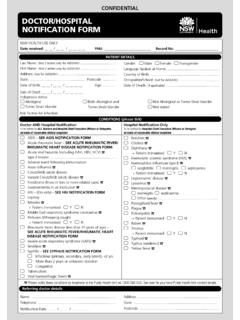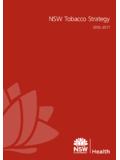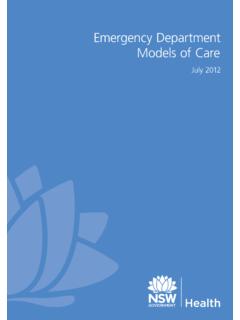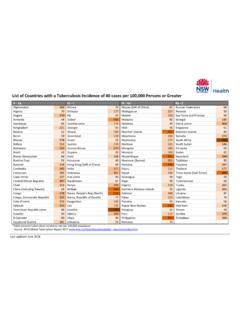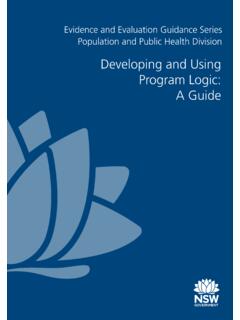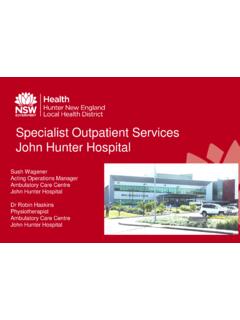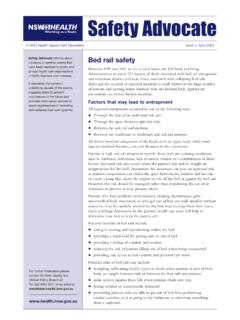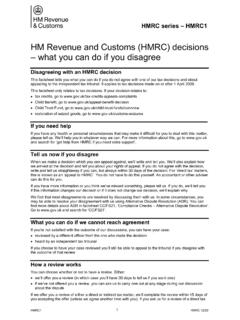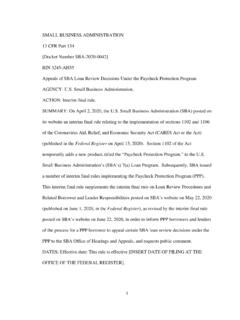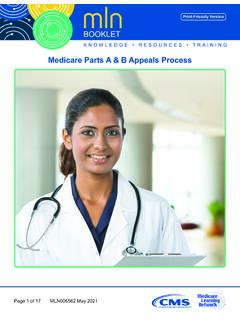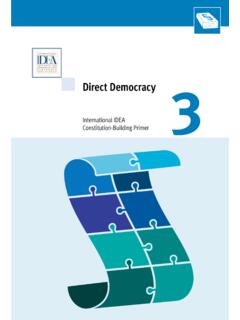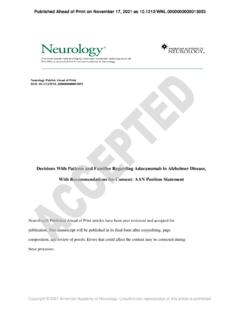Transcription of Conflict resolution in end of life treatment decisions: a ...
1 Conflict resolution in end of life treatment decisions: a rapid review Ken Hillman, Jack Chen An Evidence Check Review brokered by the Sax Institute for the NSW Department of Health November 2008. o g o i f This report was prepared and written by: Ken Hillman and Jack Chen from The Simpson Centre for Health Services Research, University of New South Wales. The Sax Institute, November 2008. This work is copyright. It may be reproduced in whole or in part for study training purposes subject to the inclusion of an acknowledgement of the source. It may not be reproduced for commercial usage or sale. Reproduction for purposes other than those indicated above requires written permission from the copyright owners. Enquiries regarding this report may be directed to the: Manager Knowledge Transfer Program The Sax Institute Phone (02) 9514 5950. Fax (02) 9514 5951. Email: Suggested Citation: Hillman, K., Chen, J. Conflict resolution in end of life treatment decisions: An Evidence Check rapid review brokered by the Sax Institute ( ) for the Centre for Epidemiology and Research, NSW.
2 Department of Health; 2008. Disclaimer: This Evidence Check Review was produced using the Evidence Check methodology in response to specific questions from the commissioning agency. It is not necessarily a comprehensive review of all literature relating to the topic area. It was current at the time of production (but not necessarily at the time of publication). It is reproduced for general information and third parties rely upon it at their own risk. The Sax Institute CONTENTS. 1 Executive Summary 1. 2 Introduction 8. 3 Methodology for Searches 12. 4 Definitions Used in This Document for Issues Related to 14. End-of-Life (EOL) Care 5 A Description of Strategies Used to Avoid Conflict 15. Pre-emptive measures to avoid Conflict 15. Community awareness and advanced directives 15. Enduring Guardian 15. Futility 17. Strategies to avoid Conflict in acute hospitals before admission to the ICU 18. Communication 21. Clinical practice guidelines for end-of-life care and decision making 27.
3 Cultural, religious and racial aspects of end-of-life care 32. Direct interventions dealing with Conflict at the End-of-Life 34. Striving for consensus 35. The role of ethical guidelines 36. Mediation 39. Tribunals 42. The legal system 45. Engaging society 52. 6 Focussing on the Review Questions 55. Question 1: 55. What factors are known to contribute to disputes arising between family members and treating clinical teams about the withholding or withdrawal of life-sustaining treatment ? Question 2: 56. Are there specific groups where conflicts arise more frequently? Question 3: 56. What proactive measures have been used to mitigate against the likelihood of disputes arising? Page i The Sax Institute Question 4: 57. How successful have these measures been in avoiding Conflict and why? Question 5: 57. Do these proactive measures have different impacts based on patient groups? Question 6: 57. What factors have been identified as barriers or facilitators to implementing proactive measures?
4 Question 7: 68. What dispute resolution measures have been deployed to resolve the conflicts ( professional mediators based within hospitals, ethics committees, and courts)? Question 8: 69. How successful have these measures been in resolving the Conflict and why? Question 9: 70. Do these dispute resolution measures have different impacts based on patient groups? Question 10: 70. What factors have been identified as barriers or facilitators of implementing dispute resolution techniques? References 71. Appendix 87. Table 1 87. Table 2 91. Table 3 110. Table 4 112. Table 5 113. Table 6 114. Page ii The Sax Institute EXECUTIVE SUMMARY. While there are many documents and published articles around end-of-life (EOL). care, including withdrawing and withholding treatment , there are very few that directly refer to how to manage Conflict and even fewer that have scientifically tested or compare different approaches. This is not surprising, as the management of Conflict does not readily lend itself to scientific and rigorous testing using conventional research methodologies.
5 There is an inherent assumption that if the many guidelines around how to manage EOL care are followed, there will be minimum Conflict . While this assumption has not been tested, it is intuitively appealing . Conflict around EOL issues can occur between clinicians, between patients and their relatives; or between the relatives of patients, especially when the patient is incompetent; or between relatives and clinicians who disagree about the most appropriate management plan. There is also an inherent Conflict between society and its expectations around what modern medicine can potentially offer. Potentially irresolvable Conflict is usually related to either to a decision to cease active management or around how the process of withdrawing or withholding treatment should occur. NSW Health explores existing options for directly resolving Conflict in EOL care in its document, Guidelines for End-of-Life Care and decision Making'. ( ). Obviously, there are no straightforward solutions to EOL Conflict .
6 Rational arguments can often be made for either party's approach. Because of the very nature of the Conflict , it is important, whenever possible, that a conclusion is reached rather than a judgement. Judgements neither reflect the complex nature of the issues nor do they allow satisfactory resolution of the highly charged emotional nature of the Conflict . This review explores some of the ways to prevent EOL Conflict , starting with community awareness and advance planning for EOL, especially in the event of the person being incapacitated and unable to make rational decisions. There are currently attempts around Australia to better inform our society of the need for advanced care planning in case the person is not capable of making decisions at the EOL. However, these are often imprecisely constructed and do not involve all the potential parties involved in EOL care. The State of Oregon in the United States of America (USA) has developed a State-wide initiative which uses standardised forms, filled in by clients in conjunction with family doctors.
7 It is agreed that the directive is always placed on the front page of the patient's notes in hospital. Admission to hospital is often prevented by shared electronic information between nursing homes, ambulance services and emergency departments (EDs). This multifaceted approach September 2008 Page 1. The Sax Institute has been successful in decreasing hospital admissions and making patient's wishes explicit, therefore probably reducing the risk of EOL Conflict . Many episodes of Conflict at the EOL, especially in the intensive care unit (ICU) come about when other hospital specialists on general wards avoid discussions around dying and use phrases such as . do you want everything done? with patients and their families. This leads to unrealistic expectations by relatives and potential Conflict at the EOL. Specialists working in intensive care may have to increasingly be involved with the diagnosis of dying as they best understand the limitations and potential benefits of further active treatment and therefore are key players in making a diagnosis of dying, when further active treatment would be futile.
8 Increased consultations with intensivists may decrease unrealistic expectations and potential Conflict . NSW Health could encourage hospitals to take up these issues when formulating local policies. Hospitals around the world are increasingly employing rapid response systems (RRS) such as medical emergency teams (MET) in order to recognise and respond to serious illness early. However, many patients who are naturally dying in a predictable way are increasingly being subject to these emergency calls. Early studies in Australia suggest that this can also be an opportunity for diagnosing and managing dying patients at an earlier stage and, together with palliative care teams, provide more appropriate and earlier care. As NSW has pioneered the concept of RRS, the Department may consider supporting pilot trials in this area. These, and other initiatives around managing dying patients in general hospital wards, can also be reinforced by the use of integrated care plans such as the one used in Liverpool, in the United Kingdom (UK) and adopted by the National Health System (NHS).
9 This could be an opportunity for NSW Health to bundle standardised initiatives for managing EOL patients. Communication is probably the most important element in preventing EOL Conflict both in the prevention of Conflict and resolving it once it has occurred. This is intuitive and well known but the challenge is how to improve communication. Some of the communication strategies that have been used include a standardised brochure on dying, including withdrawing and withholding treatment , which could be made available in all NSW hospitals, especially in ICUs. There are many published practical points using strategies which could also be summarised and provided to all staff in ICUs and other parts of the hospital. Improved undergraduate and postgraduate education in these areas is probably easier said than done. It is probably more realistic for NSW hospitals to include clear guidelines around communication in a standardised State care plan around EOL care. Another option that could be considered is to sponsor a course similar to the American Medical Association, conducted over two days, which is specifically designed to address care at the EOL.
10 Many of the above strategies have some evidence to support their effectiveness in improving EOL care but little in the way of specifically reducing Conflict . September 2008 Page 2. The Sax Institute As with the principles of communication, there is no shortage of excellent documents from many countries, governments and professional bodies around guidelines on how to manage EOL matters effectively. However, as with the principles of communication, the challenge is how to implement the guidelines. There is the danger that, as with many guidelines and published glossy pamphlets, they sit on shelves or do not make their way down to the patient/clinician interface in a meaningful way. Perhaps incorporating guidelines and the principles of communication into State-wide and standardised care plans with appropriate dissemination and sustainability programmes may assist in implementing the excellent theory into everyday practice. In some areas of NSW, over half the population were born outside the country.
